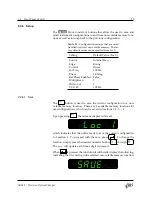
3.4 Commands
45
Parameters shown in { } and [ ] are not always required. Parameters in
{ } are required to set a value, and should be omitted for queries. Param‑
eters in [ ] are optional in both set and query commands. Parameters
listed without surrounding characters are always required.
Do
not
send ( ) or { } or [ ] as part of the command.
Multiple parameters are separated by commas. Multiple commands
may be sent on one command line by separating them with semicolons
(;) so long as the input buffer does not overflow. Commands are termi‑
nated by either
⟨
CR
⟩
or
⟨
LF
⟩
characters. Null commands and whites‑
paces are ignored. Execution of the command does not begin until the
command terminator is received.
Token
parameters (generically shown as
z
in the command descriptions)
tokens
can be specified either as a keyword or as an integer value. Command
descriptions list the valid keyword options, with each keyword followed
by its corresponding integer value. For example, to set the frequency
source to Internal Freq, the following two commands are equivalent:
SRCE INT
—
or
—
SRCE 0
For queries that return token values, the return format (keyword or in‑
teger) is specified with the
TOKN
command.
3.4.2
Notation
The following notation is used in the command descriptions:
Symbol
Definition
f
,
g
Floating‑point value
i
,
j
Unsigned integer
z
Literal token
(?)
Required for queries; illegal for set commands
var
Parameter always required
{
var
}
Required parameter for set commands; illegal for queries
[
var
]
Optional parameter for both set and query forms
3.4.3
Examples
Each command is provided with a simple example illustrating its usage.
In these examples, all data sent by the host computer to the SR542 are
set as
straight teletype font
, while responses received by the
host computer from the SR542 are set as
slanted teletype font
.
The usage examples provided below for each command vary with re‑
spect to set/query, optional parameters, and token formats. They are
not exhaustive, and are intended to provide a convenient starting point
for user programming.
SR542 Precision Optical Chopper
















































